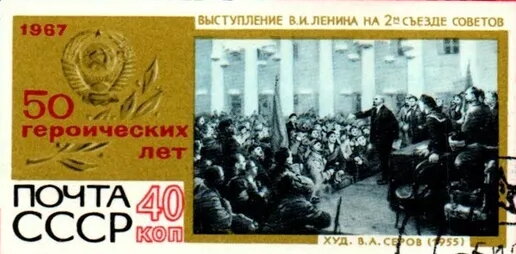Stamp: Lenin Addressing Second Soviet Congress, V.A. Serov (1955) (Soviet Union, USSR 1967)
Lenin Addressing Second Soviet Congress, V.A. Serov (1955) (Soviet Union, USSR 1967)
05 November (Soviet Union, USSR ) within release 50th Anniversary of Great October Revolution (2nd issue) goes into circulation Stamp Lenin Addressing Second Soviet Congress, V.A. Serov (1955) face value 40 Russian kopek
| Stamp Lenin Addressing Second Soviet Congress, V.A. Serov (1955) in catalogues | |
|---|---|
| Michel: | Mi: SU 3421 |
| Unificato: | Un: SU 3296A |
Stamp is horizontal format.
Stamp from souvenir sheet. Smaller than Sg:SU 3474 and imperforate.Also in the issue 50th Anniversary of Great October Revolution (2nd issue):
- Stamp - Builders of Communism, D.M. Merpert & Ya.N. Skripkov (1965) face value 40;
- Stamp - Lenin Addressing Second Soviet Congress, V.A. Serov (1955) face value 40;
Stamp Lenin Addressing Second Soviet Congress, V.A. Serov (1955) it reflects the thematic directions:
An anniversary is the date on which an event took place or an institution was founded in a previous year, and may also refer to the commemoration or celebration of that event. For example, the first event is the initial occurrence or, if planned, the inaugural of the event. One year later would be the first anniversary of that event. The word was first used for Catholic feasts to commemorate saints. Most countries celebrate national anniversaries, typically called national days. These could be the date of independence of the nation or the adoption of a new constitution or form of government. The important dates in a sitting monarch's reign may also be commemorated, an event often referred to as a "Jubilee".
A coat of arms is an heraldic visual design on an escutcheon (i.e. shield), surcoat, or tabard. The coat of arms on an escutcheon forms the central element of the full heraldic achievement which in its whole consists of shield, supporters, crest, and motto. A coat of arms is traditionally unique to an individual person, family (except in the United Kingdom), state, organisation or corporation.
Communism (from Latin communis, 'common, universal') is a left-wing to far-left sociopolitical, philosophical, and economic ideology within the socialist movement, whose goal is the creation of a communist society, a socioeconomic order centered around common ownership of the means of production, distribution, and exchange that allocates products to everyone in the society based on need. A communist society would entail the absence of private property and social classes, and ultimately moneyand the state (or nation state).
Famous People refers to the fame and public attention accorded by the mass media to individuals or groups or, occasionally, animals, but is usually applied to the persons or groups of people (celebrity couples, families, etc.) themselves who receive such a status of fame and attention. Celebrity status is often associated with wealth (commonly referred to as fame and fortune), while fame often provides opportunities to make money.
Painting is the practice of applying paint, pigment, color or other medium to a solid surface (support base). The medium is commonly applied to the base with a brush, but other implements, such as knives, sponges, and airbrushes, can be used. Painting is a mode of creative expression, and the forms are numerous. Drawing, gesture (as in gestural painting), composition, narration (as in narrative art), or abstraction (as in abstract art), among other aesthetic modes, may serve to manifest the expressive and conceptual intention of the practitioner. Paintings can be naturalistic and representational (as in a still life or landscape painting), photographic, abstract, narrative, symbolistic (as in Symbolist art), emotive (as in Expressionism), or political in nature (as in Artivism). A portion of the history of painting in both Eastern and Western art is dominated by spiritual motifs and ideas. Examples of this kind of painting range from artwork depicting mythological figures on pottery, to Biblical scenes rendered on the interior walls and ceiling of the Sistine Chapel, to scenes from the life of Buddha or other images of Eastern religious origin. In art, the term painting describes both the act and the result of the action. The support for paintings includes such surfaces as walls, paper, canvas, wood, glass, lacquer, clay, leaf, copper and concrete, and the painting may incorporate multiple other materials including sand, clay, paper, plaster, gold leaf, as well as objects. The term painting is also used outside of art as a common trade among craftsmen and builders.





